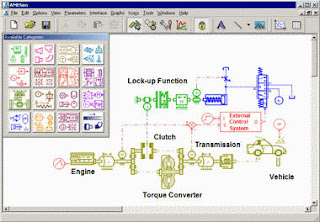
A graphical environment for modeling, simulation and analysis of dynamic engineering systems, AMESim is based on a large set of validated libraries issued from different physical domains. AMESim allows you to access rapidly the ultimate goal of modeling: the analysis and optimization of your design.
Focusing on physics, AMESim frees the engineer from numerical aspects. The basic element concept, which lies behind each model, provides basic engineering elements that can be combined to describe all functions of the component or system in the model. Thereby, engineers don't have to worry about code writing.
User Interface
The AMESim graphical interface enables the user to build complex models by choosing among a collection of components. The resulting sketch is then easily understandable, as close as possible to what a design engineer could expect. Various levels of models can be selected for each component.
The user can also set parameters and units in a friendly way. The modeling process divided into four modes (build sketch, select model complexity, set parameter and finally, run simulations and perform analysis) enables the user to work quickly and efficiently.
Multi-domain system design
The AMESim platform provides a simulation environment for multi-domain system design with a large set of libraries covering multiple domains and applications. Focusing on physics, AMESim offers both a structured multiport approach for the modeling of physical systems and a block diagram approach for control systems. This effective and clear concept for communication of model information provides a clear-cut technique to model physical systems, capture and re-use engineering knowledge, and finally to greatly facilitate the sharing of engineering efforts.
Key Points
Adaptability & Reusability
Multi-domain simulation platform
Structured libraries of physical models
Various model complexity levels
Designed to capitalize and share know-how
Comprehensive documentation
Open Platform
Interface with CAE software such as Matlab®, Simulink®, Flux® or in-house code
C Code generation
Access to library's source code
Cross platform: Windows, UNIX and Linux
Unrivaled Numerical Core
Automatic and adaptive selection of the integration method
Discontinuity handling
Model linearization
Advanced Features
Sensitivity analysis
Parametric study analysis
FFT and Linear analysis
HTML report generator
Animation

No comments:
Post a Comment